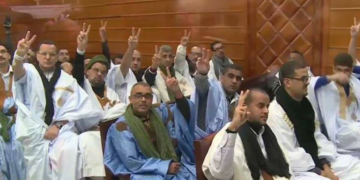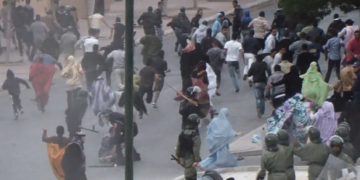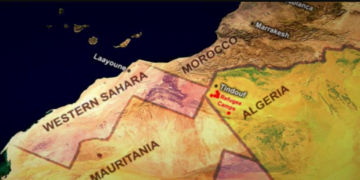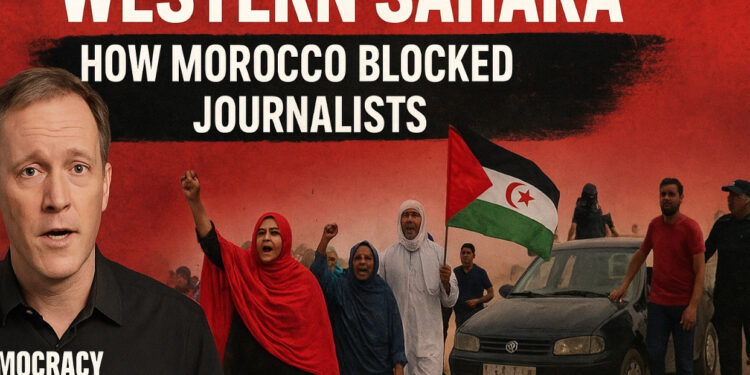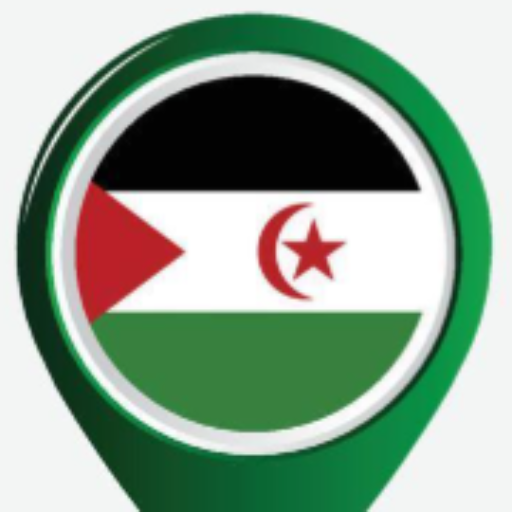Introduction: A Land Without Witnesses
Western Sahara remains one of the most silenced and media-restricted territories in the world. Morocco enforces strict control over journalists and human rights organizations, blocking most attempts to document what is happening inside the occupied territory.
In this blackout, a team from Democracy Now! managed to enter Laayoune, the occupied capital of Western Sahara, in 2016, producing one of the most revealing investigative reports ever published about the region:
“Four Days in Occupied Western Sahara — A Rare Look Inside.”
The report did more than capture images; it exposed — with firsthand footage — how Moroccan authorities track, intimidate, and obstruct journalists, and how protest movements are suppressed away from international attention.
⸻
1. A Visit Surrounded by Surveillance
Constant Intelligence Tracking
From the moment the Democracy Now! team entered Laayoune, they were followed closely by Moroccan intelligence agents and plain-clothes police.
The journalists later explained that they felt under surveillance at every step — in the streets, near their hotel, and even when speaking to local Sahrawis.
Preventing Coverage of a Sahrawi Protest
One of the strongest moments in the report was when the team attempted to cover a peaceful Sahrawi protest.
Before they could reach the location, several civilian cars filled with Moroccan settlers moved in deliberately to block the journalists’ vehicles, preventing them from arriving before Moroccan police dispersed the demonstrators.
The coordination and speed of these actions revealed a structured, state-directed attempt to obstruct media coverage.
⸻
2. Why Morocco Fears Free Media in Western Sahara
1. Because Cameras Reveal the Reality
Any independent coverage would show:
• Protest repression
• Arbitrary arrests
• Police violence
• Settlement expansion
• House raids
• Silencing of local journalists
For this reason, nearly all international journalists are barred from entering the territory; those who succeed often face immediate obstruction or expulsion.
2. Because Silence Protects the Official Narrative
With no external witnesses, the state maintains the narrative that:
“The region is stable and separatists are few.”
Democracy Now!’s footage — along with reports from Human Rights Watch and Amnesty International — completely contradicts this narrative.
3. Because Sahrawi Journalists Are Arrested Instantly
With no international media present, Sahrawi citizen journalists face:
• Arrest
• Beatings
• Confiscation of phones
• Charges such as “insulting officials” or “threatening public order”
• Forced confessions
• Trials without due process
Groups like Equipe Media, along with independent Sahrawi reporters, have been repeatedly targeted.
⸻
3. The Democracy Now! Report Breaks the Wall of Silence
The American media team’s visit was one of the very few independent entries into the territory in many years, and its impact was significant because it:
✔ Documented Moroccan obstruction tactics
Captured on video — including settlers blocking roads, security tailing journalists, and police intimidation.
✔ Recorded direct testimonies from Sahrawi citizens
Stories of arrests, torture, beatings, and repression of peaceful activism.
✔ Exposed the reality of an occupation hidden from the world
At a time when Morocco restricts access to NGOs, journalists, and observers.
⸻
4. Media Absence: Morocco’s Green Light for Repression
When cameras disappear, repression expands.
In Western Sahara today, this has translated into:
• A complete media blackout
• Expulsion of foreign reporters
• Criminalization of Sahrawi journalism
• Violent dispersal of protests
• Forced disappearances
• Arrest of activists without international scrutiny
The absence of independent reporting is not accidental — it is a strategic tool that enables the Moroccan state to operate without accountability.
⸻
Conclusion
The Democracy Now! visit marked a rare break in the wall of silence surrounding Western Sahara.
Despite Moroccan intelligence surveillance, settler roadblocks, and systematic attempts to stop them, the team managed to show the world a glimpse of what Sahrawi civilians endure daily:
Media blackout, repression, intimidation, and a struggle to make their voices heard.
In a land where silence serves power, every independent report becomes a lifeline — a vital reminder that the truth can still escape, even from the most tightly controlled places.


